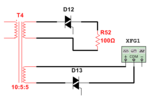mrinalmani
Advanced Member level 1
- Joined
- Oct 7, 2011
- Messages
- 463
- Helped
- 60
- Reputation
- 121
- Reaction score
- 58
- Trophy points
- 1,318
- Location
- Delhi, India
- Activity points
- 5,285
Hi
The figure attached depicts a scenario in which two solid state switches are used and only one is ON at a time.
The problem is that the transformers are high frequency transformers running at 100KHz. Back to back MOSFETs could be used to implement the switches, but I am thinking to use triacs.
I am looking at high dV/dt three quadrant triacs.
dV/dt of the transformer voltage is around 5kV/us. Maximum allowed dV/dt of the triac with gate open is 1kV/us.
How much improvement in dV/dt rating of the triac can be expected with its gate shorted to the anode terminal (by using MOSFET gate driver)? Will it be reliable to use a triac in such applications?
Thank you
The figure attached depicts a scenario in which two solid state switches are used and only one is ON at a time.
The problem is that the transformers are high frequency transformers running at 100KHz. Back to back MOSFETs could be used to implement the switches, but I am thinking to use triacs.
I am looking at high dV/dt three quadrant triacs.
dV/dt of the transformer voltage is around 5kV/us. Maximum allowed dV/dt of the triac with gate open is 1kV/us.
How much improvement in dV/dt rating of the triac can be expected with its gate shorted to the anode terminal (by using MOSFET gate driver)? Will it be reliable to use a triac in such applications?
Thank you
